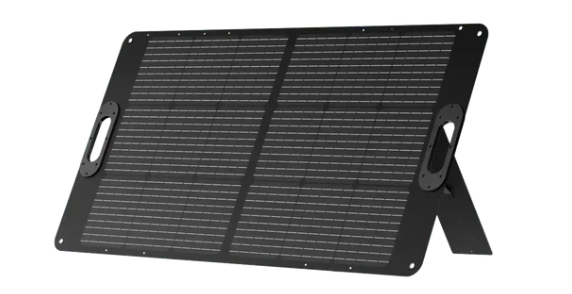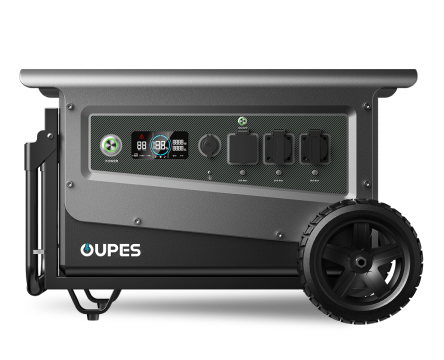
Overview
Solar power systems are designed to deliver clean, reliable energy, but there are times when output drops unexpectedly—or stops entirely. Whether you are using a rooftop solar system, a portable power station, or a solar generator, understanding the causes of power loss is essential for proper maintenance. According to the National Renewable Energy Laboratory (NREL), solar systems typically operate with over 95% reliability, meaning issues are usually preventable or easily diagnosed.
This guide explains the most common reasons why your solar panels may not be generating power, and how to troubleshoot both rooftop systems and portable solar generators used for camping, home backup, off-grid living, or outdoor activities. Brands like OUPES offer portable solar power solutions that can help diagnose problems or provide emergency backup power when traditional systems fail.
How Solar Power Generation Works
Solar Panels Convert Sunlight Into DC Power
Photovoltaic (PV) cells absorb sunlight and generate direct current (DC) electricity. This output depends on solar irradiance, panel efficiency, and environmental conditions.
Inverter Converts DC Into Usable AC Power
Most homes and appliances require alternating current (AC). The inverter performs this conversion and monitors system performance. A faulty inverter can result in zero solar output.
Charge Controller (Portable Solar Generators)
In portable solar power systems, such as a solar generator or portable power station, the charge controller regulates voltage to protect the internal battery and ensure stable energy production.
Grid or Battery Storage
For grid-tied homes, the grid acts as backup. Off-grid homes rely on battery banks. If either fails, your solar output may appear lower or nonexistent.
Common Reasons Solar Is Not Generating Power
1. Insufficient Sunlight
Cloud cover, shading from trees, snow, or seasonal changes can reduce output dramatically. The EIA reports that solar production can drop up to 80% on heavily overcast days.
2. Dirty or Obstructed Panels
Dust, bird droppings, leaves, or snow can block sunlight. A study from the University of California found that unclean panels can lose 10–25% efficiency.
3. Faulty Inverter
If your inverter displays an error or no lights, your system may stop generating power. Inverters typically last 8–12 years and are one of the most common failure points.
4. Wiring or Connection Issues
Loose connectors, corrosion, rodent damage, or aging cables can interrupt power flow. This is common in older systems or installations not meeting NEC electrical standards.
5. Tripped Breaker or Safety Shutoff
Ground faults, overloads, or maintenance procedures may trip breakers. Your system cannot generate usable power until these switches are reset safely.
6. Panel Degradation or Damage
Solar panels degrade 0.5%–1% annually. Cracked glass, hot spots, and delamination reduce production or stop it entirely.
7. Charge Controller Problems (Portable Systems)
Portable solar generators depend on a charge controller. If it fails or becomes overloaded, the panel will not charge the power station.
8. Incorrect Solar Panel Position
Panels must face optimal sunlight. A tilt error of even 10 degrees can reduce annual production by up to 15%.
9. Grid Outage (For Grid-Tied Systems)
Grid-tied solar automatically shuts down during outages to protect utility workers—a requirement under IEEE 1547. In this case, portable solar generators help supply backup power.
How to Diagnose Solar Power Issues
Step 1: Check Sunlight and Shading
Make sure panels receive unobstructed sunlight. Seasonal shading patterns change throughout the year.
Step 2: Inspect Panels for Dirt or Damage
Clean with water and a soft brush. Inspect for cracks, discoloration, or hotspots.
Step 3: Review Inverter Status
Look for warning lights or error codes. Restart if recommended by your manual.
Step 4: Test the Wiring
Ensure no frayed wires, corrosion, or disconnected cables. Use a multimeter if trained.
Step 5: Verify the Charge Controller (Portable Generators)
Ensure the solar panel is connected with the correct voltage and polarity. Confirm the controller is not in protection mode.
Step 6: Check Your Utility Meter (Grid-Tied)
Some meters indicate whether the system is exporting or idle. Contact your utility if measurements seem wrong.
Step 7: Try Another Solar Panel (Portable Systems)
Testing with a known working panel helps identify whether the issue is the panel, cable, or power station.
Comparison: System Issues vs. Environmental Issues
| Issue Type | Examples | Impact on Power | Fix Difficulty |
|---|---|---|---|
| Environmental | Clouds, snow, shading, dust | Moderate to severe | Easy |
| System Hardware | Inverter failure, damaged panels | Severe (0 output) | Medium to high |
| Electrical | Loose wiring, tripped breakers | Moderate to severe | Medium |
| User Setup | Wrong tilt, incorrect connections | Mild to moderate | Easy |
How Portable Solar Generators Help
Power Backup During Grid Shutdown
When grid-tied solar stops working during outages, portable solar generators—such as those from OUPES—provide immediate emergency power for essentials like lights, communication devices, and medical equipment.
Diagnostic Tool for Solar Panels
Portable power stations can test solar panel output by connecting panels directly to the input port and checking wattage readings. This helps identify whether the problem is with the rooftop system or the panels themselves.
Reliable Off-Grid Energy Source
For cabins, RVs, and remote sites, portable solar generators ensure energy availability without relying on the grid or complex wiring systems.
FAQ
1. Why are my solar panels producing zero watts?
Check for inverter issues, shading, tripped breakers, or disconnected wiring. Zero output often suggests a system failure.
2. Can dirty solar panels stop power generation?
Yes. Heavy dirt, snow, or debris can block up to 100% of sunlight, resulting in no output.
3. Does temperature affect solar output?
Yes. High temperatures reduce efficiency. Most panels lose 0.3–0.5% output per °C above 25°C.
4. Why does my solar stop working during an outage?
Grid-tied systems automatically shut down to protect utility workers. Portable solar generators can supply backup power.
5. How can I test if my solar panel is working?
Use a multimeter or connect it to a portable power station input and observe the real-time wattage.




























